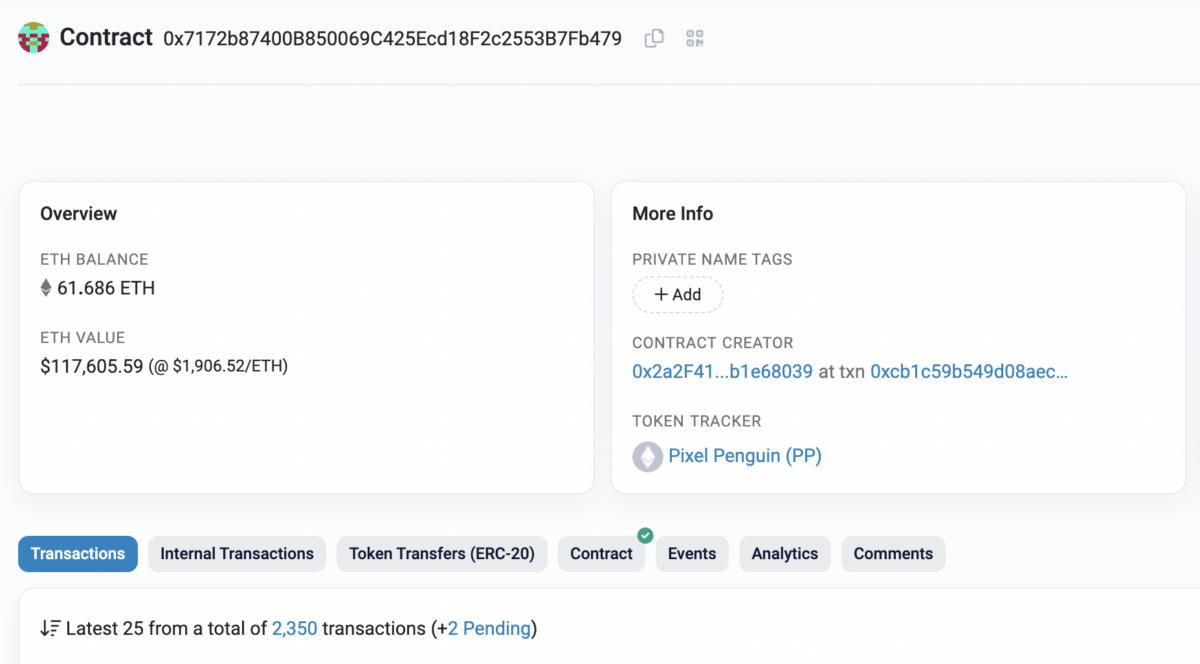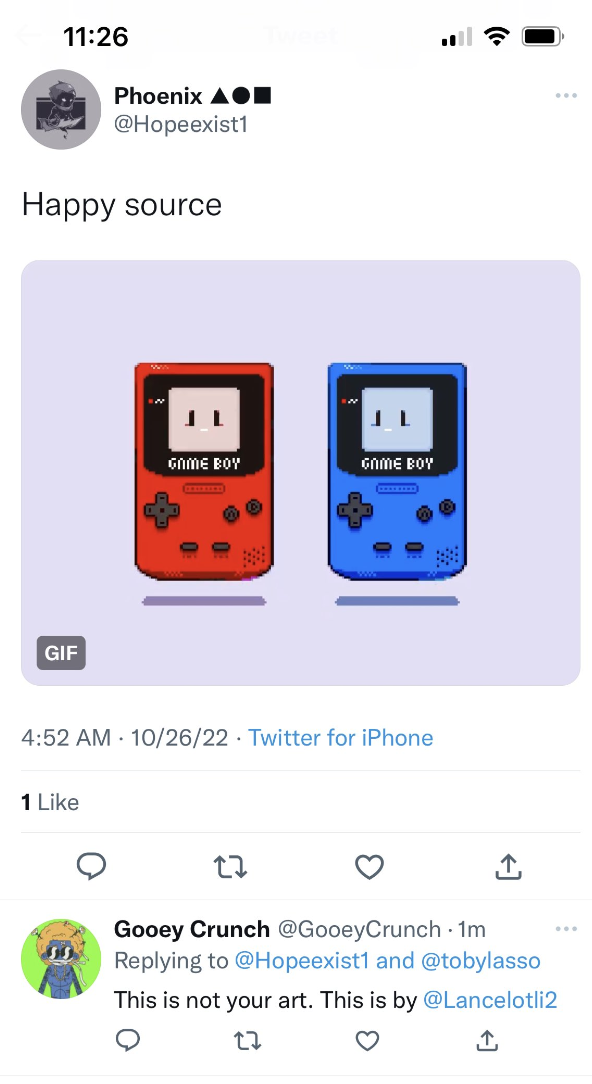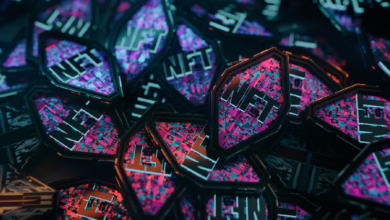How an NFT Scammer Faked a Cancer Charity to Raise $117K

The NFT community is reeling from what can only be described as a punch to its collective gut on May 30.
After a consistent downturn of NFT art sales volume in recent months — followed by the sudden, frenzied rise of highly speculative crypto memecoins and Web3 figureheads asking their followers to send them money for no reason (and succeeding) — artists and collectors alike were left feeling particularly soured on the Web3.
So, it was welcome news when well-known NFT influencer Andrew Wang tweeted the following to his audience of nearly 200,000 on May 30: “I woke up today to see one of my friends trending on Twitter, @hopeexist1,” Wang wrote. “She made a collection to help herself battle cancer, and some awesome Web3 people spotlighted her today, so I’d like to add to it.”
Wang was referencing a Chinese pixel artist named Sarah. Known as hopeexist on Web3 Twitter, her work has been collected by some of the biggest names in the space, including Drift. Sarah had been battling lacrimal gland cancer, an illness that affects the eyes. To help raise funds to cover her medical bills, she created a 10K PFP NFT collection called Pixel Penguins in February 2023. With Wang and others drawing attention to the collection, Pixel Penguins quickly minted out.
Within a few hours, $117,000, along with Sarah’s Twitter profile, disappeared, with the funds moving out of the project’s contract and into new blockchain addresses. It was a rug-pull scam — and one of the longest cons in Web3 history.

How hopeexist played the long game
Fraud is nothing new to Web3. Project founders pull the rug out from their communities all the time, and bad actors are constantly finding ways to separate unsuspecting NFT lovers from their art or crypto tokens. What makes hopeexist’s scam unique is how the person behind the account, whoever they really are, built up a level of communication and trust with some of the space’s most seasoned veterans before executing their plan.
Wang, for example, had been in contact with hopeexist for the better part of 2022, the con artist having established a connection with him by commenting on his Twitter posts in a supposed attempt to draw attention to their art. While promoting Pixel Penguins this week, Wang even explicitly called attention to the fact that hopeexist’s collection was not a scam and that he’d “put [his] rep on the line” in doing so.
the artist’s name is @Hopeexist1 and i started collecting her 1/1 pixel art about a half year ago when she posted her work in my replies hoping id see it. in a space filled with underrated artists who deserve more exposure, she was another, and yet, special pic.twitter.com/VhWL68K32h
— andrew wang (@andr3w) December 26, 2022
I’ll put my rep on the line to say this is for real amidst all the scams in our space. I speak with her art teacher often when she’s gone for treatment and he says she’s the best student he’s ever had, that her talent is too precious, that she must survive. He cares like a father pic.twitter.com/bIgzLNXPaT
— andrew wang (@andr3w) May 30, 2023
But hopeexist’s cancer play is old, dating back to at least 2021, in which Web3 collectives were promoting their work as a way to raise funds for their treatment. Once hopeexist disappeared after the Pixel Penguins mint and it became clear that “Sarah” was not who she said she was, Wang hopped on a Twitter Space to address the situation, apologizing for his lack of due diligence and if anyone bought into the project because he promoted it.
“I woke up, saw it trending, [and thought], ‘Ok, it’s another chance to do good.’”
Andrew Wang
“I woke up, saw it trending, [and thought], ‘Ok, it’s another chance to do good.’ She’s an artist that I collect,” Wang said in response to questions of how much research he did into the artist.
Part of that Twitter Space was devoted to a healthy discussion of how Web3 enthusiasts should go about doing their own research, with some claiming that not many individuals are going to do more than a few minutes of looking through an artist’s social profiles and artwork before deciding if they are legitimate or not.
Some have criticized DachshundWizard and Levi, other NFT influencers who promoted the project, for failing to look into hopeexist’s claims before singing Pixel Penguins’ praises. In the fallout of the rug pull, critics have pointed to the fact that the artist had been called out in the past for shady behavior, having listed stolen art on their Foundation page.
This account @Hopeexist1 is selling STOLEN ART on their foundation page. DO NOT BUY!
— GooeyCrunch ✊ (@GooeyCrunch) November 5, 2022

Others, themselves past victims of someone taking advantage of their goodwill, believe that getting burned by scammers while trying to support a good cause isn’t reason to come down on good intentions. This kind of social engineering, they say, is common, and we should empathize with those who want to trust and believe others, especially those in dire situations.
The community responds
The mood in the Web3 community has been at a palpable low since news of the rug pull spread, with artists and collectors expressing their exasperation with the fact that, even while explicitly trying to counteract the toxicity of the space, they were met with more scams and bad actors. In the same Twitter Space in which Wang addressed followers’ concerns, Web3 influencer and ambassador to The333Club, DancingEddie, shared precisely this feeling.
“[The trends we’ve seen are] something that we are really repulsed by, so repulsed that I’d rather put money toward something that I believe,” Eddie said. “This seemed like a reasonable and aptly timed thing to believe in. It’s absurd to me that we look for some respite from the absurdity of the space and go right back into it.”
Others noted how the increasing frequency and presence of scams make it all the more difficult for Web3 evangelists to promote the tech to non-crypto natives.
Morally corrupt individuals have overtaken the timeline. Crypto is in need of a massive reboot if it’s ever to be taken seriously.
— Bharat Krymo (@krybharat) May 30, 2023
What did you enjoy paying for the most?
— Mando (@rektmando) May 31, 2023
Is Web3 worth the trouble?
In the aftermath of the rug pull, many are wondering just how low Web3 can sink. The common refrain that gets trotted out when the NFT community takes a hit is that there are still good people doing good things in the space and that, overall, it’s worth having, despite the difficulties. All clichés are boring in their self-evident truth, but that shouldn’t stop people from sitting with the fact that it’s not all terrible; quite the contrary.
For example, Western art aesthetic champion Jeremy Booth recently put together an open edition for Emmie Sperandeo, a photographer who documents life in the Western U.S. who sustained multiple skull fractures after being thrown from a bucking horse onto a fence railing. Priced at 0.011 ETH, 114 editions have been minted with five days left on the OE’s run. If you’re one of the individuals feeling bleak about the state of Web3 at the hands of scammers, this is one of many good causes to contribute to.
gm
“For Emmie” is now available on @manifoldxyz
All proceeds go directly to supporting Emmie’s road to recovery. Link below. pic.twitter.com/RF2Ph7CPii
— jeremybooth (@jeremybooth) May 30, 2023
Another fact worth remembering is that rug pulls scams are made possible by Web3’s decentralized, pseudonymous nature. Until the space engineers a way around having its cake and eating it too, these risks will always be present, and NFT enthusiasts have to take the good with the bad.
Ultimately, each person in Web3 will have to make their own choice about whether or not they think the crypto and NFT world is one still worth inhabiting. Could you benefit from a mental health break? Or even a short break from Web3 altogether? Do what you feel is best, and don’t listen to anyone who tries to chide you for “giving up in the bear only to come back in the bull.”
Nobody has the right to judge you for how you decide to prioritize taking care of yourself in this chaotic, confusing, and sometimes extremely disheartening Web3 space. It’s not going anywhere — and neither are we.





